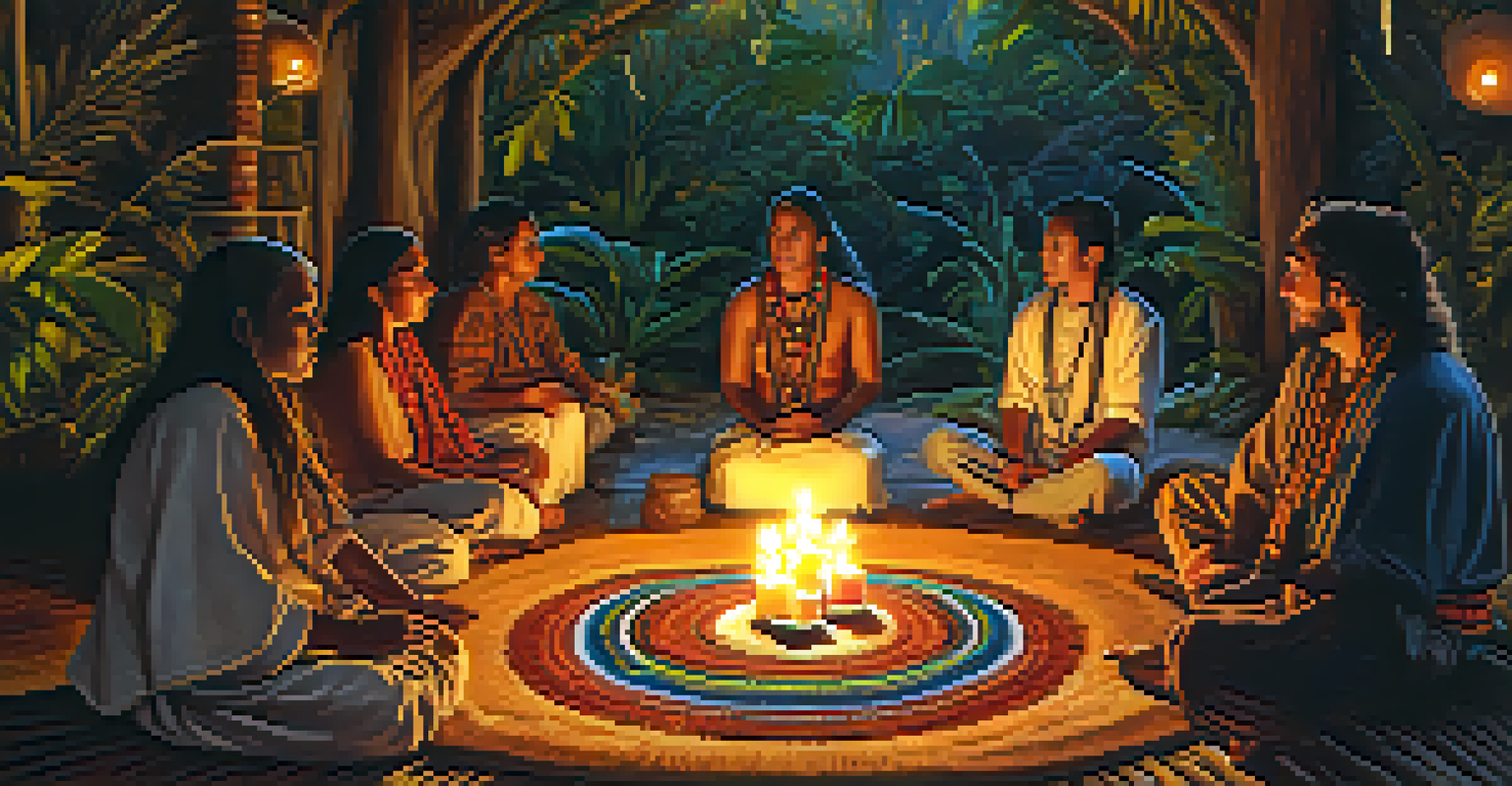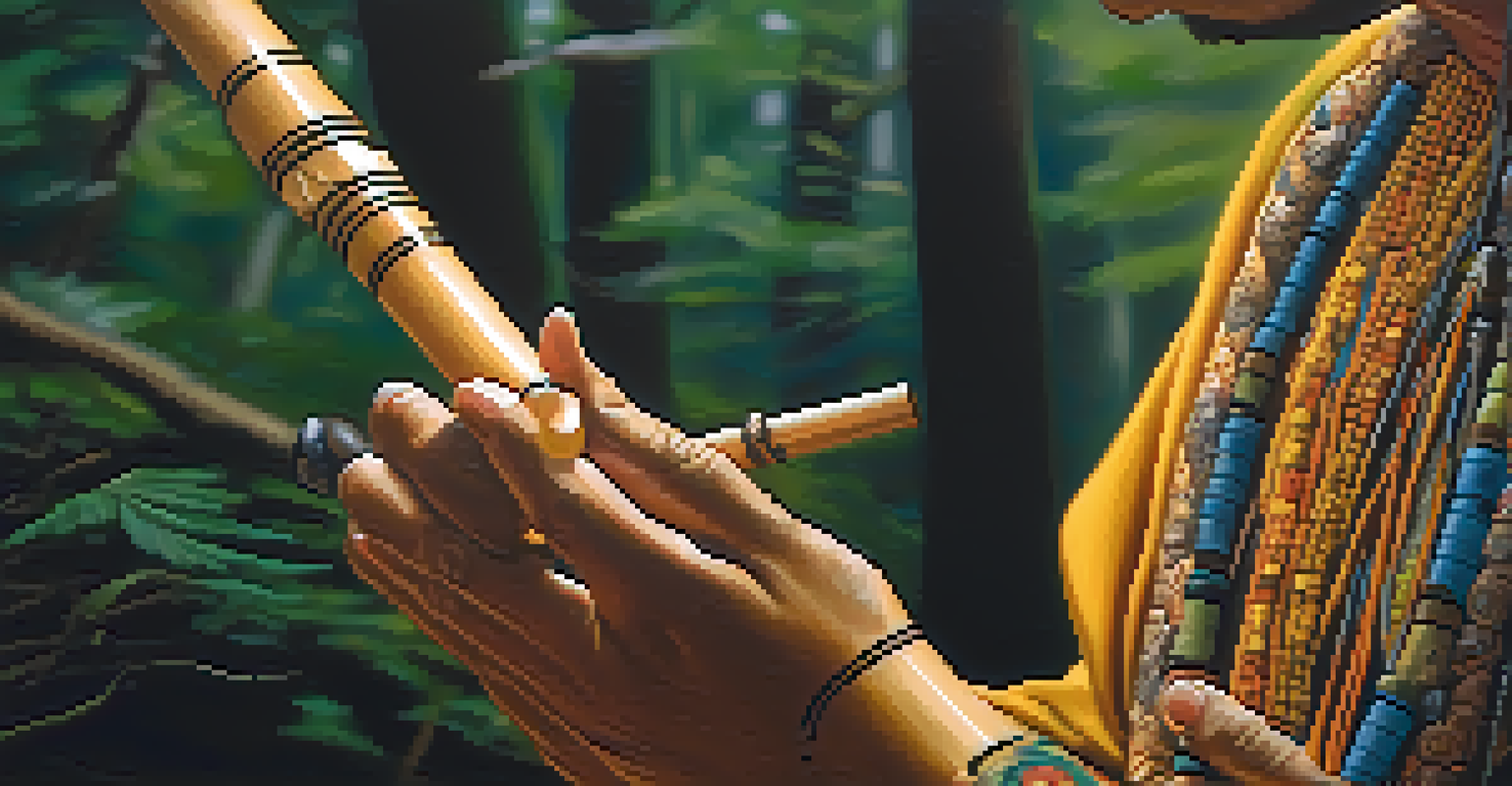The Psychological Effects of Music During Ayahuasca Journeys

Understanding Ayahuasca and Its Cultural Significance
Ayahuasca is a traditional Amazonian brew known for its psychoactive effects, often used in spiritual ceremonies. It combines the Banisteriopsis caapi vine and the Psychotria viridis leaf, creating a potent mixture that induces altered states of consciousness. These ceremonies are rich in cultural significance, often led by shamans who guide participants through their journeys.
Music can change the world because it can change people.
The experience of consuming ayahuasca can be intense and transformative, often leading individuals to confront deep-seated emotions and past traumas. Music plays a crucial role in these ceremonies, serving as a guide and facilitator for participants navigating their inner worlds. The sounds, rhythms, and melodies can evoke strong emotional responses, shaping the overall experience.
In many indigenous cultures, music is considered a vital component of healing and spiritual practices. It helps set the atmosphere for the journey, creating a safe space for participants to explore their consciousness. Understanding this cultural context is essential for appreciating the profound psychological effects of music during ayahuasca experiences.
The Role of Music in Setting the Ceremony's Atmosphere
Music in ayahuasca ceremonies is not just background noise; it plays a pivotal role in establishing the emotional landscape. The right melodies can evoke feelings of calm, safety, and introspection, which are crucial for participants to open up to their experiences. This atmospheric setting encourages individuals to dive deeper into their subconscious minds.

For example, gentle, soothing sounds might help participants relax, while more intense rhythms can prompt emotional release or catharsis. The shaman often selects specific songs or chants that resonate with the energy of the ceremony, reflecting the intentions set by the group. This intentionality can significantly influence the journey's outcome.
Music Enhances Ayahuasca Experiences
The use of music in ayahuasca ceremonies creates an emotional landscape that facilitates healing and emotional release.
Moreover, the presence of live music, often performed by the shaman or musicians, creates a communal experience that fosters connection among participants. This shared musical experience can amplify feelings of unity, providing comfort and support as individuals confront challenging emotions during their journeys.
Music as a Catalyst for Emotional Release
One of the most powerful psychological effects of music during an ayahuasca journey is its ability to facilitate emotional release. Participants often encounter suppressed emotions that surface during the experience, and music can encourage them to process these feelings safely. The right song can act as a trigger, helping individuals to cry, laugh, or express joy, which can be incredibly cathartic.
Where words fail, music speaks.
Furthermore, certain musical patterns or rhythms can resonate with an individual’s emotional state, providing a sense of validation and understanding. For instance, a haunting melody might echo feelings of sorrow, allowing participants to feel seen and heard. This connection between music and emotion is a profound aspect of the ayahuasca experience.
In this sense, music becomes a therapeutic tool, guiding participants through their emotional landscapes. It enables them to confront and release emotions that may have been buried for years, leading to healing and personal growth. This transformative process is often at the heart of why individuals seek out ayahuasca ceremonies.
Creating Safe Spaces Through Music
Safety is paramount during ayahuasca ceremonies, especially considering the intense psychological experiences that can arise. Music plays a vital role in fostering this sense of security, enveloping participants in a comforting soundscape. This creates an environment where individuals feel protected enough to explore their innermost thoughts and emotions.
When participants hear familiar melodies or soothing sounds, it can anchor them amidst the swirling emotions that ayahuasca can bring forth. In contrast, jarring or dissonant music can create anxiety or discomfort, emphasizing the importance of thoughtful song selection. The shaman's expertise in curating the musical experience is crucial for maintaining a safe atmosphere.
Safety Through Musical Atmosphere
Thoughtfully selected music fosters a sense of safety, allowing participants to explore their innermost thoughts during intense experiences.
Additionally, the communal aspect of music during these ceremonies helps build trust among participants. Sharing the experience of music fosters connections and mutual support, which can be incredibly reassuring. This sense of belonging is essential for individuals as they navigate often vulnerable and challenging emotional landscapes.
The Therapeutic Benefits of Sound Healing
Sound healing is an ancient practice that aligns closely with the use of music in ayahuasca ceremonies. Many participants report therapeutic benefits, including reduced anxiety, improved mood, and enhanced self-awareness, all attributed to the healing power of sound. The vibrational qualities of music can resonate deeply within individuals, facilitating emotional and spiritual healing.
In addition to the immediate effects during the ceremony, the therapeutic benefits of sound can extend beyond the experience itself. Many participants find that the music they encountered during their journey continues to resonate with them long after the ceremony ends. This lingering effect can serve as a touchstone for personal growth and reflection.
Moreover, incorporating sound healing practices into everyday life can further enhance these benefits. Whether through listening to calming music, participating in sound baths, or practicing mindfulness with sound, individuals can carry the healing qualities of music into their daily routines, reinforcing the positive effects experienced during their ayahuasca journey.
Navigating Challenging Emotions with Musical Guidance
During ayahuasca journeys, participants may confront challenging emotions, including fear, grief, or anxiety. Music serves as a guide for navigating these turbulent feelings, helping individuals to process and integrate their experiences. A well-chosen song can provide a sense of direction, leading participants through the darker moments toward healing and resolution.
For instance, a powerful, uplifting melody might emerge just as a participant is grappling with heavy emotions, providing a much-needed reprieve. This interplay between challenging emotions and musical guidance creates a dynamic journey that can lead to profound insights and transformations. It's as if the music acts as a compass, guiding the way through the emotional storm.
Integration of Musical Journeys
Reflecting on and integrating the musical experiences from ceremonies can enhance personal growth and sustain transformation.
Additionally, the supportive role of music can help participants feel less alone in their struggles. Knowing that others share similar emotional experiences fosters empathy and connection, making it easier to confront difficult feelings. This communal aspect of the journey, facilitated by music, can be incredibly empowering.
Integrating Musical Experiences Post-Ceremony
The journey doesn't end when the ceremony is over; integrating the musical experiences is vital for lasting transformation. Participants are often encouraged to reflect on the songs that resonated with them during their journey and consider their meanings. This reflection can deepen the understanding of personal insights gained during the ceremony.
Creating playlists of the music encountered during the ceremony can serve as a powerful tool for ongoing integration. These playlists can evoke memories and emotions, acting as a bridge between the ceremonial space and everyday life. Listening to these songs can help participants stay connected to their experiences and insights, reinforcing their healing journey.

Moreover, sharing stories and experiences with others who have participated in similar ceremonies can enhance the integration process. Discussing the role of music in their journeys offers additional perspectives and insights, allowing individuals to process their experiences more fully. This community support can be invaluable in sustaining the transformation initiated during the ayahuasca ceremony.